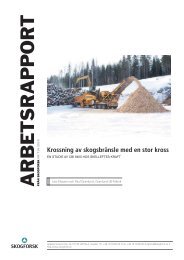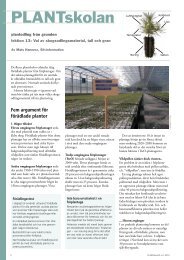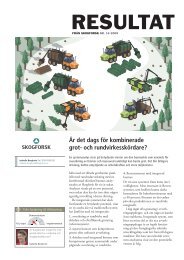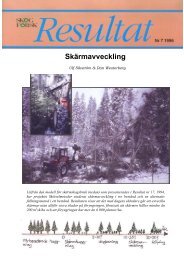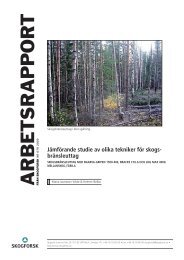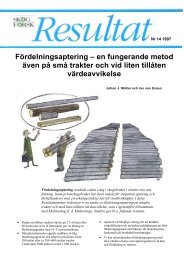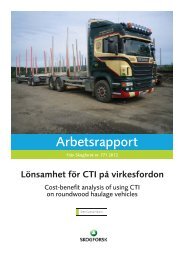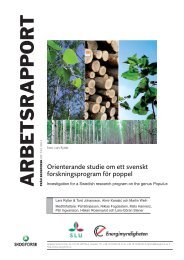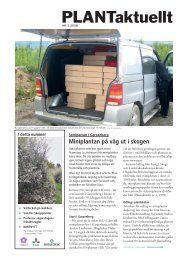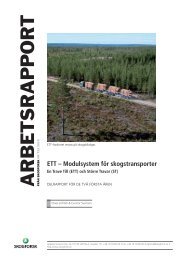Download pdf - Skog og landskap
Download pdf - Skog og landskap
Download pdf - Skog og landskap
Create successful ePaper yourself
Turn your PDF publications into a flip-book with our unique Google optimized e-Paper software.
14. THE IMPACT OF TIMBER HAULAGE ON LOADING<br />
OF FOREST ROADS<br />
Grzegorz Trzciński & Waldemar Sieniawski<br />
Warsaw University of Life Sciences-SGGW, Faculty of Forestry, Department of Forest Utilization,<br />
Warsaw, Poland<br />
Grzegorz_Trzcinski@sggw.pl, Waldemar.Sieniawski@wl.sggw.pl<br />
Introduction<br />
The significance of proper timber haulage, and primarily organizing appropriate road network, has<br />
been emphasized since XIX century, where C.A. Schenck (1911) briefly defined the issue:<br />
„Indeed, it might be stated, that forestry is essentially a problem of transportation”. Costs incurred<br />
by the forestry enterprise to build and maintain a network of forest roads are a significant part, and<br />
are often the biggest cost of operating the forestry. From data of the General Directorate of State<br />
Forests in Poland (PGL LP) in 2007 for the construction, renovation and maintenance of road<br />
infrastructure earmarked 330 million PLN - 6.3% of total costs (84.93 million Euro). Among the<br />
costs associated with maintenance of road infrastructure and providing adequate technical quality,<br />
a significant part are the costs arising from the conditions of the project in differentiated<br />
physi<strong>og</strong>raphic conditions, and particularly to ensure the proper construction of forest road<br />
pavements.<br />
Defining the road’s load is associated with quantitative and qualitative analysis of traveling<br />
vehicles. On its basis it is possible to obtain data necessary to determine the axle load<br />
equivalency factors. Vehicles with a greater number of equivalent standard axles is characterized<br />
by an increased impact on the surface of the road. Number of researchers were engaged in<br />
determination of traffic and its structure resulting from the destination and types of vehicles driving<br />
on forest roads. Optimization of timber haulage in load capacity context and resulting gross<br />
vehicle weight GVW (car with trailer) were involved, Hamsley, Devlin and McDonnell. Overloading<br />
has an impact on forest road surface and accelerates its degradation, leading to the absence of<br />
proper timber transport.<br />
Most of 32 million m3 timber harvested In Poland is being moved from place where is harvested<br />
and collected in forest directly to recipient or in place of handling (rail, depot handling) by road<br />
transport. This means that forest roads are exposed to high tonnage vehicles, often exceeding the<br />
GVW limit, what in effect gives load on the axis of the vehicle above the accepted design<br />
parameters and is the cause of accelerated degradation of the forest road.<br />
Weight of timber load is a very variable feature. Vehicles are often overloaded and identifying<br />
GVW on the base of technical parameters of truck and weight of load calculated from number of<br />
m3 is highly inaccurate. The objective of this work was to examine the actual loads on the forest<br />
road from vehicles used for timber exports, resulting from the gross vehicle weight (GVW) as the<br />
sum of its own empty truck weight and trailer and load and the simultaneous distribution of<br />
pressure on vehicle axles.<br />
Material and methods<br />
As a place of study we selected the two major recipients of wood from the area of the northern<br />
Poland: first – accepting daily approximately 800-1000 m3 of pine l<strong>og</strong>s (WC0) and the second -<br />
receiving 2000-4000 m3 of medium-sized material (S2) of various species. All the timber is<br />
delivered by high-tonnage trucks.<br />
On the handling area, using gravity measurements, we made weight controls of every truck going<br />
in – GVW, and every truck going out – empty set weight. The difference between full and empty<br />
vehicle gave weight of load. The volume of timber transported in m3 was determined by a receipt<br />
issued by the seller. Measurement of load on each axle of high-tonnage vehicle has made using a<br />
mobile platform scale, where the weight of single wheel axle was determined. The hypothesis that<br />
differences in obtained results GVW and volume of timber transported between the various types<br />
of cars and the size of the load for a given set of axes are statistically significant has been tested<br />
by analysis of variance. Regression model of the GVW and the weight of load, depending on the<br />
load (in m3) of transported wood, has also been calculated.<br />
21



